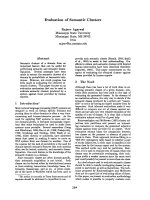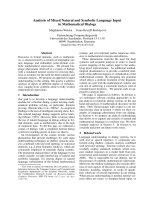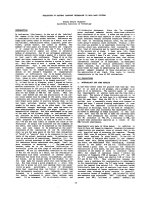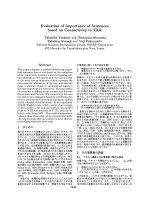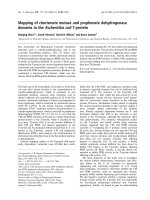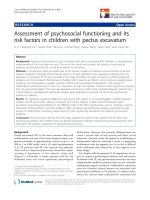Báo cáo khoa học: "Evaluation of clinical, laboratory and morphologic prognostic factors in colon cancer" ppsx
Bạn đang xem bản rút gọn của tài liệu. Xem và tải ngay bản đầy đủ của tài liệu tại đây (244.78 KB, 7 trang )
BioMed Central
Page 1 of 7
(page number not for citation purposes)
World Journal of Surgical Oncology
Open Access
Research
Evaluation of clinical, laboratory and morphologic prognostic
factors in colon cancer
Michele Grande*, Giovanni Milito, Grazia Maria Attinà, Federica Cadeddu,
Marco Gallinella Muzi, Casimiro Nigro, Francesco Rulli and
Attilio Maria Farinon
Address: University Hospital Tor Vergata, department of surgery, University hospital Tor Vergata, Viale Oxford, 81 00133 Rome, Italy
Email: Michele Grande* - ; Giovanni Milito - ; Grazia Maria Attinà - ;
Federica Cadeddu - ; Marco Gallinella Muzi - ; Casimiro Nigro - ;
Francesco Rulli - ; Attilio Maria Farinon -
* Corresponding author
Abstract
Background: The long-term prognosis of patients with colon cancer is dependent on many
factors. To investigate the influence of a series of clinical, laboratory and morphological variables
on prognosis of colon carcinoma we conducted a retrospective analysis of our data.
Methods: Ninety-two patients with colon cancer, who underwent surgical resection between
January 1999 and December 2001, were analyzed. On survival analysis, demographics, clinical,
laboratory and pathomorphological parameters were tested for their potential prognostic value.
Furthermore, univariate and multivariate analysis of the above mentioned data were performed
considering the depth of tumour invasion into the bowel wall as independent variable.
Results: On survival analysis we found that depth of tumour invasion (P < 0.001; F-ratio 2.11), type
of operation (P < 0.001; F-ratio 3.51) and CT scanning (P < 0.001; F-ratio 5.21) were predictors of
survival. Considering the degree of mural invasion as independent variable, on univariate analysis,
we observed that mucorrhea, anismus, hematocrit, WBC count, fibrinogen value and CT scanning
were significantly related to the degree of mural invasion of the cancer. On the multivariate analysis,
fibrinogen value was the most statistically significant variable (P < 0.001) with the highest F-ratio (F-
ratio 5.86). Finally, in the present study, the tumour site was significantly related neither to the
survival nor to the mural invasion of the tumour.
Conclusion: The various clinical, laboratory and patho-morphological parameters showed
different prognostic value for colon carcinoma. In the future, preoperative prognostic markers will
probably gain relevance in order to make a proper choice between surgery, chemotherapy and
radiotherapy. Nevertheless, current data do not provide sufficient evidence for preoperative
stratification of high and low risk patients. Further assessments in prospective large studies are
warranted.
Published: 8 September 2008
World Journal of Surgical Oncology 2008, 6:98 doi:10.1186/1477-7819-6-98
Received: 12 May 2008
Accepted: 8 September 2008
This article is available from: />© 2008 Grande et al; licensee BioMed Central Ltd.
This is an Open Access article distributed under the terms of the Creative Commons Attribution License ( />),
which permits unrestricted use, distribution, and reproduction in any medium, provided the original work is properly cited.
World Journal of Surgical Oncology 2008, 6:98 />Page 2 of 7
(page number not for citation purposes)
Introduction
Advances in the management of colon cancer over the
past decades have resulted in an improvement of the prog-
nosis of the disease. The proportion of stage I and II has
increased from 39.6% to 56.6% leading to a raise of five-
year relative survival from 33% in 1970s to 55.3% in
1990s [1].
Nevertheless, the five-year survival rate of colon cancer
has not improved dramatically in the last decade, remain-
ing at approximately 60%, and colon cancer is still one of
the leading killers in the Western countries [2].
In truth, despite curative resection, many patients develop
recurrence at the primary site or distant organs. These high
risk patients could be candidates for more aggressive treat-
ments (neoadjuvant chemotherapy) in order to improve
the prognosis [3]. This target requires not only the devel-
opment of new therapeutic modalities but also a reliable
preoperative stratification of high and low risk patients.
Prognostic factors derived from clinical, laboratory and
pathologic data of colorectal cancer patients have been
considered important and have been investigated in order
to make a proper choice between surgery chemotherapy
and radiotherapy, but the results of the previous studies
were often intriguing and conflicting [4,5].
Actually, most studies investigating prognostic factors for
large bowel cancers did not distinguish between the sub-
population of colon and rectal cancer, despite the differ-
ent biological characteristics, treatment modalities,
pattern of recurrence and survival rates of the two group
of neoplasms [6].
Further, it was suggested that proximal and distal colon
cancer can differ in histopathologic characteristics, molec-
ular pattern, stage of diagnosis and, consequently, clinical
outcome. Over the past 20 years, the literature has demon-
strated a stage migration of colorectal cancer from distal to
proximal sites with a tendency for proximal tumours to
present at a more advanced stage than distal tumours [7].
At the moment, the most accurate prognostic factor
remains the extension of the tumour into the bowel wall
as expressed in the Dukes classification or TNM classifica-
tion [2,4].
The main endpoint of the present study was to evaluate
the prognostic implication of many preoperative clinical,
laboratory and patho-morphological data by both univar-
iate and multivariate analysis.
Therefore, we performed two statistical analysis of clini-
cal, laboratory and patho-morphological data in a group
of patients with colon cancer, considering survival and pT
staging as the independent variables.
Materials and methods
Patients
A total of 103 patients with colon cancer, who were surgi-
cally treated between January 1999 and December 2001 at
the Department of General Surgery, University Hospital
Tor Vergata, Rome, were evaluated for eligibility.
Patients who suffered from rectal cancer, colon carcinoma
with locally advanced invasion (pT4) or colon cancer with
distant metastasis were excluded. Only elective surgery
cases were considered. Thus, out of 103 subjects, 92
patients, who underwent to curative resection and were
followed for at least 5 years, were analysed.
Preoperative staging was performed using colonoscopy,
conventional transabdominal ultrasonography, CT scan
of abdomen, barium enema, chest X-ray and blood tests
that included tumour markers.
CT scanning was performed using oral and intravenous
contrast. Patients were scanned at 5-mm intervals from
the diaphragm through the pubic symphysis. We did not
use a three-dimensional endoluminal view; we used only
transverse CT images. The assessment of extracolonic
compartment metastases of the abdomen and pelvis was
performed on 5-mm venous phase contrast-enhanced
transverse images.
Bowel wall thickening of more than 0.5 cm was consid-
ered to indicate the presence of a neoplasm. Colorectal
wall invasion was analyzed according to a modified T clas-
sification reported by Filippone et al. Contrast-enhanced
CT criteria for T staging were ≤T2 = smooth outer border
of thickened colorectal wall with a clear surrounding fat
plane, T3 = tumor with rounded or nodular advancing
margin, T4 = obliteration of fat planes between colorectal
tumor and adjacent organs. This classification was used to
address known limitations at CT in distinguishing T1 and
T2 lesions.
The cancer was found in the ileocecal junction of 11
patients (11.9%), in ascending colon of 14 patients
(15.2%), in transverse colon of 8 subjects (8.7%), in
hepatic flexure of 8 patients (8.7%), in splenic flexure of
7 patients (7.6%), in descending colon of 10 patients
(10.9%) and in sigmoid colon of 34 patients (36,9%).
Operative procedure
All patients were surgically treated. Right hemicolectomy
was performed in 14 patients, ileocecal resection in 11
cases, transverse colon resection in 8 patients, left hemi-
World Journal of Surgical Oncology 2008, 6:98 />Page 3 of 7
(page number not for citation purposes)
colectomy in 25 patients, sigmoid resection in 24 patients,
Hartmann procedure in 10 cases.
T and N staging was based on the international TNM clas-
sification, as follows: pT1, tumor invading submucosal
layer; pT2, tumor invading muscularis propria or subse-
rosa; pT3, tumor penetrating serosa and perivisceral fat;
and pT4, tumor invading adjacent organs. Lymph nodes
were likewise classified: N0, no regional lymph node
metastasis; N1, metastasis in one to three perirectal lymph
nodes; N2, metastasis in four or more perirectal lymph
nodes; and N3, metastasis in pelvic lymph nodes. The
patients were classified as follows: 5 pT1 N0 M0; 2 pT1 N1
M0; 4 pT1 N2 M0; 16 pT2 N0 M0;; 2 pT2 N1 M0; 2 pT2
N2 M0; 37 pT3 N0 M0; 14 pT3 N1 M0; 10 pT3 N2 M0.
Data analysis
Medical records of patients with colon cancer were iso-
lated in a computerized database. The database included
53 demographics, clinical, laboratory and patho-morpho-
logical parameters: name, sex, age, symptoms and major
medical problems of patients; laboratory data and neo-
plastic markers values; location, size, endoscopic appear-
ance and preoperative staging of the tumour; operation
type, degree of differentiation and pTNM of the cancer;
postoperative course, recurrence, and condition at follow-
up.
These patients returned for follow-up every 6 months dur-
ing the first 3 years and then once a year. When necessary,
telephone contact was made with the patient to obtain
up-to-date information. The dead line of follow-up was
up to January 2007. The longest follow-up time was 96
months with an average period of 60 months.
Statistical analysis was performed using the software pro-
gram Statgraphics Plus. Analysis of variance (F-ratio) was
used for comparison of quantitative parameters, whereas
qualitative parameters were analyzed by Chi-square test.
To compare the prognostic value of the statistically signif-
icant variables, multivariate analysis (Multivariate analy-
sis of variance MANOVA) was performed with 95% CI for
the means of each variable.
All P values were two-tailed. P values of less than 0.05
were considered statistically significant.
Results
Between January 1999 and December 2001, 92 patients
with colon cancer underwent surgical resection at the
Department of General Surgery, University Hospital Tor
Vergata, Rome and were included in the study.
Patients consisted of 48 males and 44 females who ranged
in age from 37 to 94 years (average age of 69.2 years). The
average interval between symptoms and diagnosis was 5.4
months (range 1–70).
In our experience 92 patients with colon cancer were
recruited between January 1999 and December 2001 and
followed up to December 2006. The average follow up
period of the 92 patients was 40.6 months (range 3–96).
The 5-year survival rate was 39.1% (36/92).
The results of univariate analyses of clinical, laboratory
and pathomorphologic data considering pT staging as the
independent variable are summarized in table 1; pT stages
were considered as 2 categories: pT < 2 and pT > 2.
Presence of mucorrhea and anismus, hematocrit value
ranging between 16,7% and 31%, WBC count between
4500 and 5800/mm
3
and fibrinogen value > 400 mg/dl
were significantly related to pT staging > 2. Further the
degree of CT scan T-staging were significantly related to pT
staging of the tumour.
Among clinical parameters, presence of mucorrhea (p <
0.005; F-ratio 8.75) appeared more significantly related to
pT staging > 2 than anismus (p < 0.05; F-ratio 4.26).
Among laboratory data, fibrinogen value > 400 mg/dl (p
< 0.0005; F-ratio 6,64) appeared more significantly
related to pT > 2 than WBC count ranging between 4500
and 5800/mm
3
(p < 0.01; F-ratio 1,90) or hematocrit
value of 16,7–31% (p < 0.05; F-ratio 2,54). Furthermore,
CT scan-T staging appeared strongly related to the patho-
logic-T staging (p < 0.01; F-ratio 5,21).
Only those variables that appeared significant in the uni-
variate analysis were considered for the multivariable
analysis. Fibrinogen value appeared the most significant
predictor of pathologic-T staging of the tumour (p <
0.001, F-ratio 5.86), as shown in table 2.
On survival analyses, the pathologic-T staging of the
tumour (p < 0.01; F-ratio 2.11), the operation type (p <
0.01; F-ratio 3.51) and the CT scanning (p < 0.05; F-ratio
5,21) appeared to be prognostic indicators (table 3).
Finally, tumour site was found significantly related nei-
ther to survival not to the degree of tumour differentiation
as shown in table 4.
Discussion
Several studies provided data regarding the survival of
patients with colorectal cancer. Different clinico-patho-
logical prognostic factors have been proposed: age, loca-
tion of the cancer, surgical procedure, radical resection,
blood transfusion, pathological type, diameter, depth of
tumor invasion, lymph node metastasis and distant
metastasis [1,2,8].
World Journal of Surgical Oncology 2008, 6:98 />Page 4 of 7
(page number not for citation purposes)
The site of the tumor is one of the prognostic factors inves-
tigated. Patients with colon cancer are considered having
a better survival than those with rectal cancer [6,7,9]. In
previous studies distal location and advanced stage of
tumor were determined as independent prognostic factors
for survival of patients with colorectal cancer [10]. In the
present study, we considered only patients with colon
cancer and, among these patients, we found relationship
neither between tumor location and survival nor between
tumor location and degree of cancer differentiation.
Differently, pathological classification is one of the prog-
nostic factors proposed for patients with colorectal cancer.
It was suggested that patients with different papillary ade-
nocarcinoma have the best outcome, patients with mod-
erately-differentiated and mucinous adenocarcinoma
have a moderate outcome, patients with signet-ring cell
poorly-differentiated adenocarcinoma have a poor prog-
nosis [11].
Current data indicates also that radical resection and type
of operation are important prognostic factors. In a recent
Table 1: Results of univariate analyses of clinical, laboratory and pathomorphologic data considering pT staging as independent
parameter
Source Sum of squares Df Mean Square R-ratio P-value
pT staging vs mucorrea
Between groups 41.2011 1 41.2011 8.75 0.005
Within groups 423.875 90 4.70972
Total correct 465.076 91
pT staging vs anismus x
Between groups 21.0117 1 21.0117 4.26 0.0519
Within groups 444,064 90 4,93405
Within groups 465,076 91
pT staging vs-fibrinogens
Between groups 453.687 78 5.8165 6.64 0.0003
Within groups 11.3889 13 0.876068
Total (correct) 465.076 91
pT staging vs WBC
Between groups 630.923 50 12.6185 1.90 0.01
Within groups 279.55 42 6.65595
Total (correct) 910.473 92
pT staging vs hematocrit
Between groups 852.117 79 10.7863 2.54 0.05
Within groups 59.5 14 4.25
Total (correct) 911.617 93
pT vs CT staging
Between groups 126.287 5 25.2575 5.21 0.01
Within groups 58.1571 12 4.84643
Total (correct) 184.444 17
Table 2: Results of multivariate analysis of clinical and laboratory data of patients with colon cancer
Source Sum of squares Df Mean Square F-ratio P-value
Main effects
A: fibrinogens 405.233 78 5.19529 5.86 0.0014
B: mucorrhea 1.38889 1 1.38889 1.57 0.2366
C: tenesmus 0.25 1 0.25 0.28 0.6059
Residual 9.75 11 0.886364
Total (correct) 465.076 91
World Journal of Surgical Oncology 2008, 6:98 />Page 5 of 7
(page number not for citation purposes)
study on prognosis of 96 patients with colon cancer, sur-
vival time and 3-year survival rate were, respectively, 24
months and 6.5% for patients who received R2 procedure,
98 months and 87.9% for patients who underwent R0
resection [1]. Further, the prognosis of the patients under-
gone left hemicolectomy (splenic flexure of colon,
descending colon and most part of sigma colon) was not
different from that of the patients undergone right hemi-
colectomy (caecum, ascending colon and hepatic flexure
of colon)[1]. Differently, in our experience type of opera-
tion was an indicator of survival (P < 0.001; F-ratio 3.51).
Several analyses confirmed the vital importance of
tumour stage, as reflected in Dukes or TNM classification,
in predicting survival [2,4,5]. The overall 5-year survival
rate of patients with colorectal cancer, reported in litera-
ture, is at least 60% and raises to 90% for Dukes A tumour
and conversely decreases to 10% for Dukes D
2
.
Accordingly, stage T4 and vascular invasion were reported
as markers of poor prognosis [12]. Petersen and col-
leagues [13] identified these factors in a series of 268
patients with stage II colonic cancer, together with posi-
tive surgical margins and perforation. Burdy et al [14]
identified stage T4 in a study of 108 colonic cancers, and
also reported independent significance for male sex,
bowel obstruction and number of nodes examined. Mor-
ris et al [12], in a observational study on 1306 patients,
reported only T4 and vascular invasion as significant fac-
tors in multivariable analysis. Mulcahy et al [15] found a
trend for prognostic significance of vascular invasion in
rectal but not in colonic cancers. Accordingly, in our expe-
rience the pT staging of the cancer was strongly related to
survival (P < 0.001; F-ratio 2.11). Therefore, histopatho-
logical factors continue to be the most valuable source of
information regarding the possible evolution of patients
with colon cancer [16,17].
Although surgical therapy is the basis of treatment for
patients with colon cancer, multimodal therapeutical con-
cepts are currently applied not only in metastatic disease
and Dukes C patients but also in Dukes B [18-20]. Further,
the introduction of new drugs has extended the therapeu-
tic options [21,22] and ongoing studies with novel tar-
geted therapies will show their results in the next years.
Other open questions include the timing of treatment
(neoadjuvant treatment for locally advanced cancer), the
duration of therapy and whether there is a real possibility
of stratifying patients for neoadjuvant treatment on the
basis of preoperative prognostic factors [23-25].
Actually, recent studies, that underlined remission rates as
high as 40% in advanced colon cancer and the efficacy of
adjuvant chemotherapy, are now leading to revaluation of
the therapeutic approach to colon cancer. Data from ani-
mal models and tumour biologic hypotheses also point to
a possible advantage for preoperative therapy to improve
disease-free survival and overall survival in colon cancer
patients [26].
Therefore, the main target of this investigation was to
identify preoperative clinical, laboratory and patho-mor-
Table 3: Prognostic indicators of survival in patients surgically treated for colon cancer
Source Sum of squares Df Mean Square R-ratio P-value
Survival vs pT staging
Between groups 136.587 15 9.10583 2.11 0.01
Within groups 328.489 76 4.32222
Total correct 465.076 91
Survival vs operation
Between groups 22292.1 6 3715.35 3.51 0.01
Within groups 89913.6 85 1057.81
Total correct 112206.0 91
Survival vs CT staging
Between groups 7770.25 5 1554.05 3.90 0.05
Within groups 4778.86 12 398.238
Total correct 12549.1 17
Table 4: Statistical correlation between tumour site and degree
of differentiation on the cancer
Degree of differentiation Site Total Significance
RL
very differentiated 5 10 15 p = n.s.
moderately differentiated 27 42 69 p = n.s.
insufficient differentiated 5 3 8 p = n.s.
Total 37 55 92
World Journal of Surgical Oncology 2008, 6:98 />Page 6 of 7
(page number not for citation purposes)
phological parameters that may be indicators of the pT
staging of the tumour.
Considering clinical data, we observed that the presence
of mucorrhea and anismus were indicators of pT staging >
2, it was suggested that these signs are also related to the
tumour size. On laboratory, we found that hematocrit
value between 16,7 and 31% and WBC count ranging
between 4500 and 5800/mm
3
were significantly associ-
ated to pT > 2. Further fibrinogen value > 400 mg/dl both
on univariate and multivariate analysis was significantly
associated to pT staging > 2; however the importance of
fibrinogen value to predict tumour invasion and progno-
sis of these patients remains uncertain, given that this
marker is not specific and it is also involved in acute-
phase reaction.
The significance of increase of CEA and CA 19-9 levels to
predict the prognosis of the patients remains a problem
for debate; in our experience CEA and CA 19-9 levels were
found indicators neither of pT staging nor of survival. Dif-
ferently, in a recent study on 103 patients with colorectal
carcinoma, Nozoe et al [27] observed that high preopera-
tive CEA and CA 19-9 were predictors of survival. On the
opposite, in a large study of 279 patients with colon can-
cer and 293 patients with rectal cancer, Tominaga et al [8]
found that, although higher preoperative CEA level group
tended to have a higher recurrence rate, preoperative CEA
level was not statistically related to the prognosis of both
groups of patients (Hazard ratio 1.34 and 1.35).
Besides this, an interesting result of our investigation is
the importance of CT scan preoperative staging both as
predictors of survival and of pT staging. These data con-
firm the diagnostic accuracy of this tool not only for the
rectum but also for the colon cancer as pointed out by
Blomqvist in a recent review on advances in preoperative
staging of colorectal cancer patients. The author under-
lines the technological advancement of CT scan related to
hardware, software, development of CT colonography,
new contrast enhancement agents [28,29].
In summary, these data confirm the vital importance of
tumour stage in predicting survival and recurrence and
provide the grounds for further work in order to assess the
prognostic significance of various clinical, laboratory,
patho-morphological markers and to define the sub-
groups of patients at different risk of recurrence who
could be treated more or less intensively.
Competing interests
The authors declare that they have no competing interests.
Authors' contributions
MG: manuscript preparation and critical review. GM: crit-
ical review. GMG: data collection and manuscript prepa-
ration. FC: literature review and manuscript preparation.
MGM: literature review. CN: data collection and literature
review. FR: critical review. AMF: critical review. All authors
read and approved the final manuscript.
References
1. Liang H, Wang XN, Wang BJ, Pan Y, Liu N, Wang DC, Hao XS: Prog-
nostic factors of young patients with colon cancer after sur-
gery. World J Gastroenterol 2006, 12(9):1458-1462.
2. Bosman FT: Prognostic value of pathological characteristics of
colorectal cancer. Eur J Cancer 1995, 31A(7/8):1216-1221.
3. Kuzu MA, Koksoy C, Kale T, Demirpence E, Renda N: Experimen-
tal study of the effect of preoperative 5-fluorouracil on the
integrity of colonic anastomoses. Br J Surg 1998, 85(2):236-9.
4. Ponz de Leon M, Sant M, Micheli A, Sacchetti C, Di Gregorio C, Fante
R, Zanghieri G, Melotti G, Gatta G: Clinical and pathologic prog-
nostic indicators in colorectal cancer. Cancer 1992, 69:626-635.
5. Wiggers T, Arends JW, Volovics A: Regression analisys of prog-
nostic factors in colorectal cancer after curative resections.
Dis Colon Rectum 1988, 31:33-41.
6. Gervaz P, Bouzourene H, Cerottini J-P, Chaubert P, Benhattar J, Secic
M, Wexner S, Givel J-C: Dukes B colorectal cancer: distinct
genetic categories and clinical outcome based on proximal
or distal tumor location. Dis Colon Rectum 2001, 44:364-373.
7. Gonzalez EC, Roetzheim RG, Ferrante JM, Campbell R: Predictors
of proximal vs. distal colorectal cancers. Dis Colon Rectum 2001,
44:251-258.
8. Tominaga T, Sakabe T, Koyama Y, Hamano K, Yasutomi M, Takahashi
T, Kodaira S, Kato T, Ogawa N: Prognostic factors for patients
with colon or rectal carcinoma treated with resection only.
Cancer 1996, 78:403-8.
9. National Cooperative Group on Pathology and Prognosis of colorec-
tal cancer: Pathology and prognosis of colorectal cancer in
Chinese young patients-an analysis of 319 cases. Zhonghua
Zhong Liu Za Zhi 1986, 8:146-148.
10. Alici S, Aykan NF, Sakar B, Bulutlar G, Kaytan E, Topuz E: Colorectal
cancer in young patients: characteristics and outcome.
Tohoku J Exp Med 2003, 199:85-93.
11. O'connell JB, Maggard MA, Sack J, Ko CY: A 10-Year outcomes
evaluation of mucinous and signet-ring cell carcinoma of the
colon and rectum.
Dis Colon Rectum 2005, 48:1161-1168.
12. Morris M, Platell C, de Boer B, McCaul K, Iacopetta B: Population-
based study of prognostic factors in stage II colonic cancer.
British Journal of Surgery 2006, 93:866-871.
13. Petersen VC, Baxter KJ, Love SB, Shepherd NA: Identification of
objective pathological prognostic determinants and models
of prognosis in Duke's B colon cancer. Gut 2002, 51:65-69.
14. Burdy G, Panis Y, Alves A, Nemeth J, Lavergne-Slove A, Valleur P:
Identifying patients with T3–T4 node-negative colon cancer
at high risk of recurrence. Dis Colon Rectum 2001, 44:1682-1688.
15. Mulcahy HE, Toner M, Patchett SE, Daly L, O'Donoghue DP: Identi-
fying stage B colorectal cancer patients at high risk of tumor
recurrence and death. Dis Colon Rectum 1997, 40:326-331.
16. Diculescu M, Iacob R, Iacob S, Croitoru A, Becheanu G, Popeneciu V:
The importance of Histopathological and clinical variables in
predicting the evolution of colon cancer. Rom J Gastroenterol
2002, 11(3):183-9.
17. Kubota K, Akasu T, Fujita S, Sugihara K, Moriya Y, Yamamoto S: Clin-
ical and pathological prognostic indicators with colorectal
mucinous carcinomas. Hepatogastroenterology 2004,
51(55):142-6.
18. Mamounas E, Wieand S, Wolmark N, Bear HD, Atkins JN, Song K,
Jones J, Rockette H: Comparative efficacy of adjuvant chemo-
therapy in patients with Dukes' B versus Dukes' C colon can-
cer: results from four National Surgical Adjuvant Breast and
Bowel Project adjuvant studies (C-01, C-02, C-03, and C-04).
J Clin Oncol 1999, 17(5):1349-55.
19. Morris M, Platell C, Mc Caul K, Millward M, van Hazel G, Bayliss E,
Trotter J, Ransom D, Iacopetta B: Survival rates for stage II colon
Publish with BioMed Central and every
scientist can read your work free of charge
"BioMed Central will be the most significant development for
disseminating the results of biomedical research in our lifetime."
Sir Paul Nurse, Cancer Research UK
Your research papers will be:
available free of charge to the entire biomedical community
peer reviewed and published immediately upon acceptance
cited in PubMed and archived on PubMed Central
yours — you keep the copyright
Submit your manuscript here:
/>BioMedcentral
World Journal of Surgical Oncology 2008, 6:98 />Page 7 of 7
(page number not for citation purposes)
cancer patients treated with or without chemoyherapy in a
population-based setting. Int J Colorectal Dis .
20. Ogata Y, Torigoe S, Matono K, Sasatomi T, Ishibashi N, Shida S,
Ohkita A, Mizobe T, Ikeda S, Ogou S, Ozasa H, Shirouzu K: Prognos-
tic factors after potentially curative resection in stage II or
III colon cancer. Kurume Medical Journal 2005, 52:67-71.
21. Waterston AM, Cassidy J: Adjuvant treatment strategies for
early colon cancer. Drugs 2005, 65(14):1935-47.
22. O'Connell MJ, Sargent DJ, Windschitl HE, Shepherd L, Mahoney MR,
Krook JE, Rayson S, Morton RF, Rowland KM Jr, Kugler JW: Rand-
omized clinical trial of high-dose levamisole combined with
5-fluorouracil and leucovorin as surgical adjuvant therapy for
high-risk colon cancer. Clin Colorectal Cancer 2006, 6(2):133-9.
23. Labianca R, Mosconi S, Garassino MC: New strategies in colon
cancer adjuvant therapy. Ann Oncol 2006, 17(Suppl
7):vii51-vii54.
24. Graziano F, Cascinu S: Prognostic molecular markers for plan-
ning adjuvant chemotherapy trias in Dukes' B colorectal can-
cer patients: how much evidence is enough? Ann Oncol 2003,
14(7):1026-38.
25. Cascinu S, Georgoulias V, Kerr D, Maughan T, Labianca R, Ychou M:
Colorectal cancer in the adjuvant setting: perspectives on
treatment and the role of prognostic factors. Ann Oncol 2003,
14(Suppl 2):ii25-ii29.
26. Jakesz R, Steger G: Primary (preoperative, neoadjuvant) chem-
otherapy of colon-cancer – a therapeutic alternative? Chirurg
1994, 65(6):497-502.
27. Nozoe T, Rikimaru T, Mori E, Okuyama T, Takahashi I: Increase in
both CEA and CA19.9 in sera is an independent prognostic
indicator in colorectal carcinoma. J Surg Oncol 2006,
94:132-137.
28. Blomqvist L, Torkzad MR: Whole-body imaging with MRI or
PECT/CT: the future for single-modality imaging in oncol-
ogy? JAMA 290(24):3248-9. 2003 Dec 24
29. Blomqvist L: Preoperative staging of colorectal cancer – com-
puted tomography and magnetic resonance imaging. Scand J
Surg 2003, 92(1):35-43.

